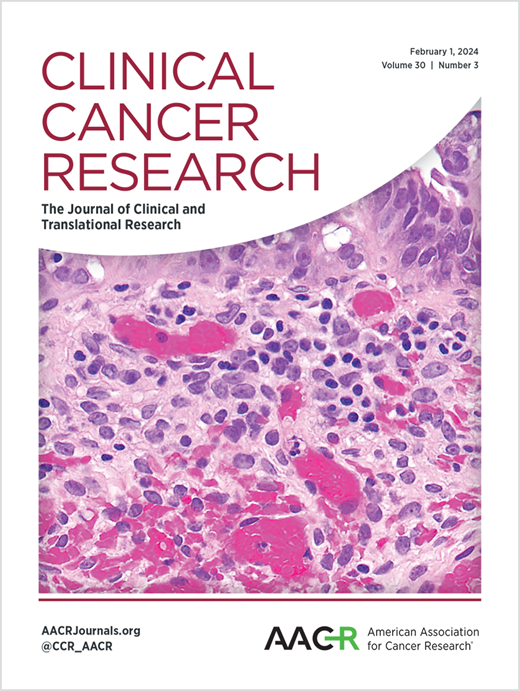The CD70-CD27 axis in cancer immunotherapy: Predictive biomarker and therapeutic target.
IF 10
1区 医学
Q1 ONCOLOGY
引用次数: 0
Abstract
The CD27-CD70 interaction is recognized as a positive costimulatory pathway for T cell priming and expansion. However, recent studies showed that chronic CD27-CD70 interaction in cancer can lead to apoptosis of T cells, rendering them dysfunctional. CD70 is expressed not only by hematological tumors but also by solid tumor cells. This expression is regulated by hypoxia-induced factor (HIF), Epstein-Barr virus (EBV) infection, and epithelial-mesenchymal transition. CD27 expression on intratumoral T cells identifies exhausted and dysfunctional T cells, as well as regulatory T cells with enhanced immunosuppressive activity. Given the preferential expression of CD70 on certain tumor cells, several therapeutic approaches including antibody-drug conjugate, anti-CD70 CAR T cells, and anti-CD70 monoclonal antibodies (mAb), have been investigated in various preclinical models and clinical trials. To date, the most significant clinical results are observed in hematological malignancies. However, no therapeutic tools specifically targeting the deleterious CD27-CD70 interaction have been developed. Most CD70-targeting mAb also deplete other CD70-expressing cells, such as activated T cells. Interestingly, chronic CD27-CD70 interaction results in the release of detectable soluble CD27 in patient plasma. The presence of high levels of soluble CD27 in plasma correlates with resistance to anti-PD-(L)1 in renal cancer, melanoma, and non-small cell lung cancer. Conversely, the absence of a predictive impact soluble CD27 in melanoma patients treated with the more toxic combination of anti-PD-1 and anti-CTLA-4 may justify therapeutic escalation with this regimen. Thus, the CD27-CD70 axis may serve as both a potential biomarker to guide the choice of immunotherapy and a novel clinical target.肿瘤免疫治疗中的CD70-CD27轴:预测性生物标志物和治疗靶点。
CD27-CD70相互作用被认为是T细胞启动和扩增的积极共刺激途径。然而,最近的研究表明,慢性CD27-CD70在癌症中的相互作用可导致T细胞凋亡,使其功能失调。CD70不仅在血液学肿瘤中表达,也在实体肿瘤细胞中表达。这种表达受缺氧诱导因子(HIF)、eb病毒(EBV)感染和上皮间质转化的调节。CD27在肿瘤内T细胞上的表达可识别耗竭和功能失调的T细胞,以及具有增强免疫抑制活性的调节性T细胞。鉴于CD70在某些肿瘤细胞上的优先表达,包括抗体-药物偶联,抗CD70 CAR - T细胞和抗CD70单克隆抗体(mAb)在内的几种治疗方法已经在各种临床前模型和临床试验中进行了研究。迄今为止,最显著的临床结果是在血液系统恶性肿瘤中观察到的。然而,目前还没有专门针对有害的CD27-CD70相互作用的治疗工具。大多数靶向cd70的单克隆抗体也会消耗其他表达cd70的细胞,如活化的T细胞。有趣的是,慢性CD27- cd70相互作用导致患者血浆中可检测到的可溶性CD27的释放。在肾癌、黑色素瘤和非小细胞肺癌中,血浆中存在高水平的可溶性CD27与抗pd -(L)1耐药性相关。相反,在使用更具毒性的抗pd -1和抗ctla -4联合治疗的黑色素瘤患者中,可溶性CD27缺乏预测性影响,这可能证明该方案的治疗升级是合理的。因此,CD27-CD70轴可以作为指导免疫治疗选择的潜在生物标志物和新的临床靶点。
本文章由计算机程序翻译,如有差异,请以英文原文为准。
求助全文
约1分钟内获得全文
求助全文
来源期刊

Clinical Cancer Research
医学-肿瘤学
CiteScore
20.10
自引率
1.70%
发文量
1207
审稿时长
2.1 months
期刊介绍:
Clinical Cancer Research is a journal focusing on groundbreaking research in cancer, specifically in the areas where the laboratory and the clinic intersect. Our primary interest lies in clinical trials that investigate novel treatments, accompanied by research on pharmacology, molecular alterations, and biomarkers that can predict response or resistance to these treatments. Furthermore, we prioritize laboratory and animal studies that explore new drugs and targeted agents with the potential to advance to clinical trials. We also encourage research on targetable mechanisms of cancer development, progression, and metastasis.
 求助内容:
求助内容: 应助结果提醒方式:
应助结果提醒方式:


